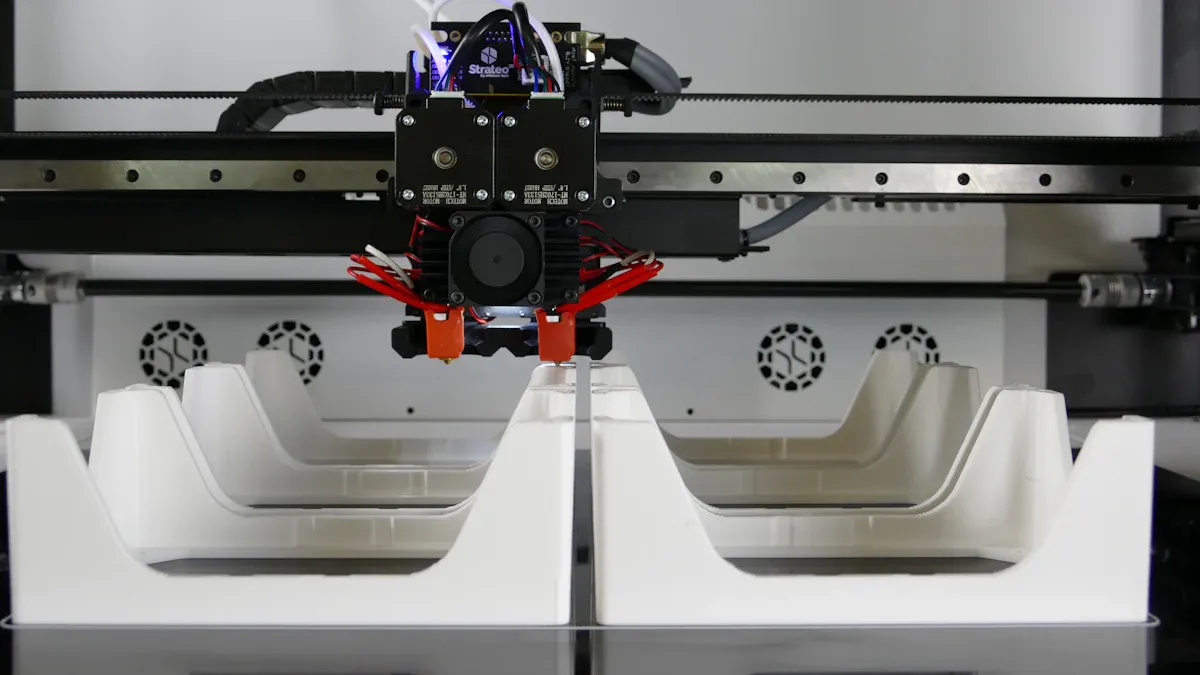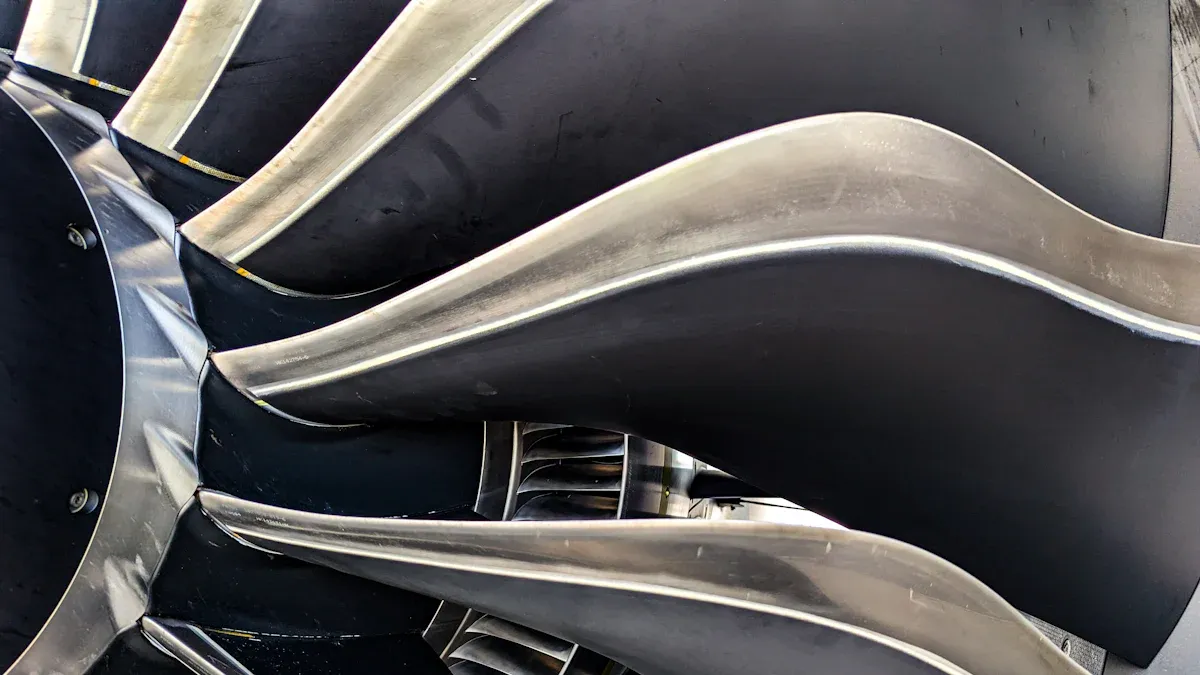Mar.
28, 2025
Contents
Precision and Tight Tolerances in Aerospace Manufacturing
Material Compatibility in CNC Machining
Complex Shapes and Testing with CNC Machining
Automation and Consistency in CNC Machining
Meeting Aerospace Industry Standards with CNC Machining

CNC machining is very important in making airplane parts.
It helps create parts with exact measurements for safety and use.
Precise machining makes sure parts stay strong in tough conditions.
Tests like simulations and prototypes check if parts work well.
Following strict rules like ISO 9001 keeps parts safe and reliable.
This technology is needed to make airplanes work safely and efficiently.
CNC machining makes exact measurements, which keeps airplane parts safe.
Automation in CNC machining lowers mistakes, making better and safer parts.
Strong materials like aluminum and titanium make airplane parts last longer.
Multi-axis CNC machines shape tricky designs fast, saving time and improving quality.
Meeting rules like AS9100 and ISO 9001 ensures parts are safe and high-quality.

Precision is very important for keeping airplane parts safe and working well. These parts must work perfectly in tough conditions like high heat and pressure. For example, jet engines and landing gear need exact sizes to work safely. Correctly sized parts lower friction and wear, saving fuel and lasting longer. Even small mistakes in size can cause part failures, risking safety or causing expensive fixes. This is why the aerospace industry uses advanced tools and checks to meet strict rules.
CNC Machining makes parts with very exact sizes, which is key for airplanes. Using computer-controlled machines, it ensures every part is made perfectly. These machines can make parts with tiny size differences, perfect for complex parts like turbine blades. CNC machines also make sure every part in a batch is the same. This is important for global fleets, where matching parts save time and improve efficiency.
Automation in CNC Machining helps avoid mistakes better than older methods. Automated systems remove human errors, making sure all parts are high quality. For airplane parts, this is very important. These systems also check tool wear and conditions, adjusting as needed to stay precise. By reducing size mistakes, automation makes airplane parts safer and more reliable, meeting strict industry standards.
Choosing the right materials is key for safe airplanes. Aluminum alloys are light and resist rust, making them great for wings and bodies. Titanium alloys handle heat well and don’t rust, so they’re used in engines and strong parts. Plastics like PEEK and polycarbonate are light and tough, perfect for inside and outside airplane parts.
Each material has special strengths. For example, aluminum like 7075 is very strong and lasts long. Titanium is used in advanced planes like the Airbus A380. These materials help planes work better and last longer.
CNC Machining works well with special aerospace materials. It makes sure hard-to-work materials like Inconel® and Invar® are shaped correctly. Inconel® can handle high heat, so it’s used in jet engines. Invar® doesn’t change size with heat, so it’s used for molds. CNC Machining keeps sizes exact to meet strict airplane rules.
This process also saves materials by reducing waste. This is important for costly materials like titanium and composites. CNC machines give the same results every time, even for tricky designs.
Some materials, like superalloys and composites, are hard to shape. CNC Machining handles these materials with great accuracy. It makes sure parts fit perfectly, even when working with titanium. This reduces tool damage and keeps parts safe.
CNC machines also make sure all parts are the same, which helps performance. They adjust for tool wear automatically, keeping parts reliable. This technology works with tough materials while staying precise and efficient.
In aerospace, complex shapes help improve how planes work. These designs make parts lighter but still strong. For example, special wing shapes help planes use less fuel. They also make parts last longer in tough conditions like heat and pressure. Using advanced shapes helps make planes better and safer.
Multi-axis CNC machines are great for making detailed airplane parts. A 5-axis machine can make things like turbine blades very precisely. These machines move in five directions at once, saving time and reducing mistakes. They also make smooth surfaces, which is important for airflow and tight seals. With fewer steps, these machines make parts faster and more accurately.
Why 5-axis CNC machines are helpful:
Make complex parts in one step, saving time.
Create very exact parts that fit perfectly.
Speed up production and improve part quality.
Quick prototypes help test airplane designs fast and cheaply. Using methods like SLA or SLS, you can make models to check size and function before making the real part. This lowers risks and ensures the final part meets strict rules.
Step | What Happens |
|---|---|
1 | Make a test model using SLA or SLS. |
2 | Check the design, size, and finish. |
3 | Create a mold for casting with silicone/epoxy. |
Quick prototypes also save money. For example, testing a design costs only a small part of the final mold price. This method helps fix problems early while keeping high-quality standards.
Automation makes aerospace manufacturing faster and more accurate. Machines create lightweight parts that save fuel. They also reduce mistakes, making parts safer and more reliable. For example, Airbus uses smart systems to track progress and fix delays. Boeing uses automated tools to save materials and avoid waste. GE Aviation watches machine data to plan repairs and prevent breakdowns.
Automation improves quality checks too. Smart systems find tiny flaws, cutting down on wasted parts. By planning better, automation speeds up production while keeping quality high.
Making the same part every time is very important. CNC machines ensure all parts match perfectly. Automated systems remove differences, so parts are always the same. This keeps airplane parts safe and working well.
For example, turbine blades and landing gear need to be exact. CNC machining makes sure they fit and work properly. This stops problems like mismatched parts, which can cause safety risks. Automated systems help make high-quality parts every time.
CNC machining saves money and reduces waste in making airplane parts. Automated machines run nonstop and avoid mistakes. They use materials like titanium and aluminum carefully, wasting less.
Automation also lowers labor costs since fewer workers are needed. High accuracy means fewer errors, saving money on fixing or remaking parts. Faster production gets parts ready sooner, cutting extra costs. These benefits keep quality high while saving money in aerospace manufacturing.
Meeting aerospace standards is very important for safe parts. AS9100 proves manufacturers meet strict aerospace quality rules. It builds on ISO 9001, which sets global quality guidelines. Together, these certifications ensure parts are made carefully and precisely.
ISO 9001: Focuses on improving and keeping customers happy.
AS9100: Adds rules for managing risks and tracking parts.
AS9100 shows dedication to making high-quality aerospace parts.
ISO 9001 provides a strong base for managing quality.
By following these rules, CNC Machining ensures all parts meet tough industry standards.
Inspections and tests are key to keeping parts high quality. Tools like Coordinate Measuring Machines (CMM) check part sizes exactly. Non-Destructive Testing (NDT), like X-rays, checks inside parts without breaking them.
Standard | What It Does |
|---|---|
ISO 9001 | Focuses on improving and satisfying customers. |
AS9100 | Adds rules for risk control and part tracking. |
Manufacturers follow these inspection steps:
Raw Materials Check: Makes sure materials are good quality.
First Article Check (FAI): Confirms first parts match designs.
In-process Check: Watches sizes during machining.
These steps make sure every part is top quality.
Tracking is very important in aerospace. It means following each part from start to finish. This ensures safety rules are followed and helps find problems if needed. Records show materials, processes, and workers involved.
Aspect | What It Means |
|---|---|
Tracking | Follows parts from creation to use. |
Quality Records | Keeps part history for checks and fixes. |
Safety Rules | Ensures safety and helps find causes of problems. |
By keeping detailed records, CNC Machining improves and ensures all parts meet safety rules.
CNC Machining is very important in making airplane parts. It creates exact parts with fewer mistakes, making them reliable. Automation helps use materials wisely and speeds up production, cutting waste and costs.
The table below shows how CNC machining helps:
Benefit | Example |
|---|---|
Uniformity | CNC machining makes sure all parts are the same every time. |
Speed | Automated machines work faster and use materials better, wasting less. |
Safety | Accurate parts lower mistakes, making airplane parts safer and stronger. |
In the future, new technology like AI and hybrid tools will improve CNC machining even more. The aerospace industry, worth over $800 billion, needs exact and safe parts, keeping CNC machining very important for progress.
CNC machining uses computers to make exact parts. Unlike older ways, it avoids human mistakes and keeps quality steady. It’s great for making tricky designs and exact sizes, which are needed for airplane parts.
Yes, CNC machines can shape many materials like aluminum and titanium. They also handle tough ones like Inconel® using special methods. This makes them perfect for making airplane parts.
CNC machining makes parts that fit perfectly, lowering failure risks. Automated systems catch mistakes and keep parts the same. By making strong and exact parts, it helps meet strict airplane safety rules.
Yes, CNC machining saves time and reduces waste. Automation lowers worker costs and uses materials wisely. While setup costs more at first, it saves money later by avoiding mistakes and speeding up work.
Automation makes sure all parts are the same, which is key for safety. It also works faster and wastes less. Automated tools check for wear and keep parts exact, ensuring top quality every time.
Navigation
Navigation
Contact Us
Tel: +86 13417419143
E-mail: [email protected]
Add:
2nd Floor, Building 7, 156 High Tech Industrial Park, Fuyuan 1st Road, Zhancheng Community, Fuhai Street, Baoan District, Shenzhen City, China.